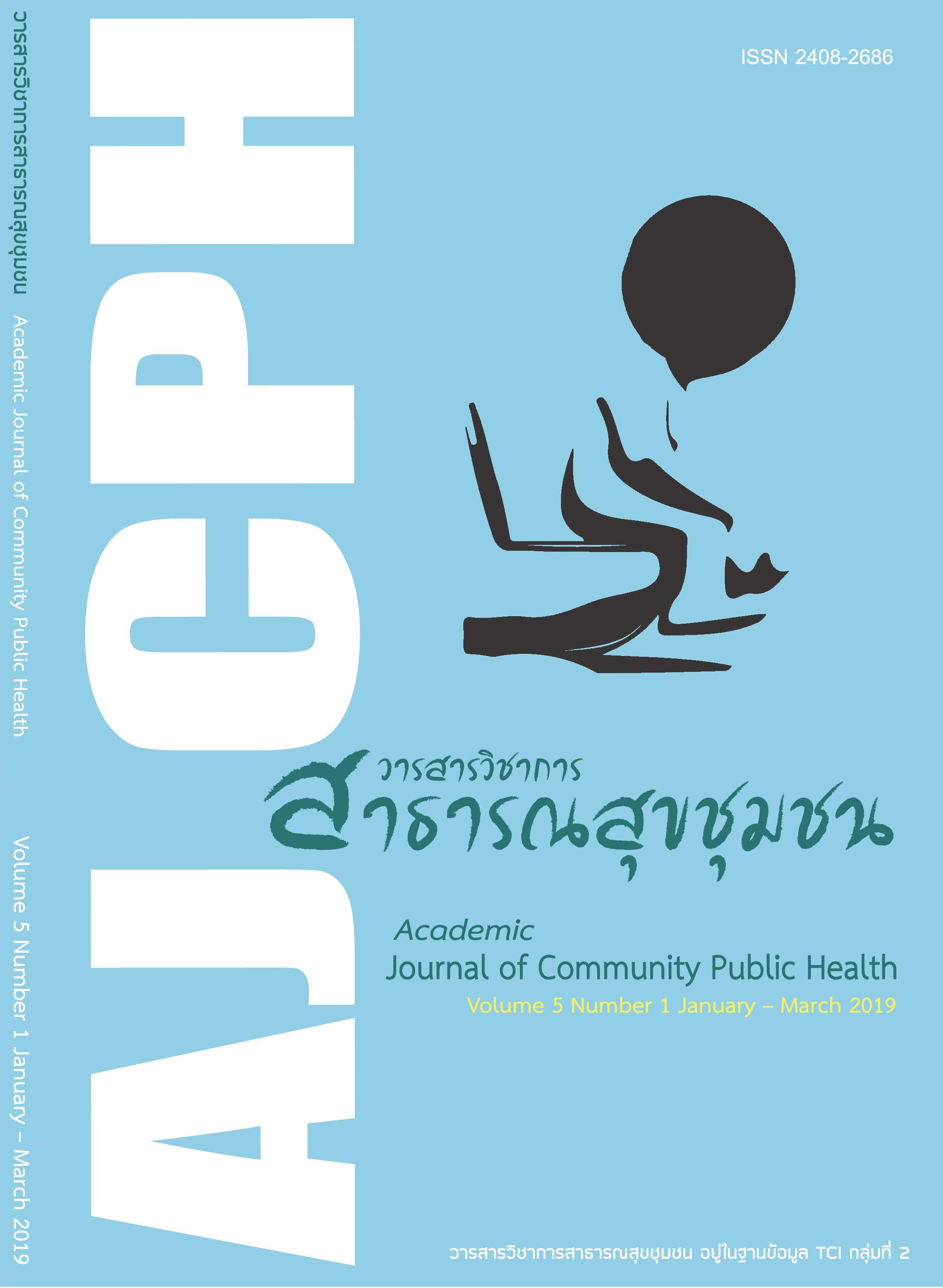ความสัมพันธ์ของไขมันร่างกายกับความรู้เกี่ยวกับกิจกรรมทางกาย และโภชนาการในวัยรุ่นตอนต้น
คำสำคัญ:
สุขภาพวัยรุ่น, ภาวะโภชนาการ, กิจกรรมทางกายบทคัดย่อ
การเพิ่มพูนความรู้เป็นวิธีการหนึ่งของการยกระดับภาวะโภชนาการ และการมีกิจกรรมทางกาย ที่เหมาะสม รวมทั้งเป็นการลดไขมันร่างกาย และความอ้วน การศึกษานี้มีวัตถุประสงค์เพื่อศึกษาความแตกต่างกันของภาวะโภชนาการ และการมีกิจกรรมทางกายจำแนกตามระดับไขมันร่างกาย และระดับกิจกรรมทางกายในวัยรุ่นตอนต้น การศึกษานี้ได้วิเคราะห์ข้อมูลที่เก็บรวบรวมมาด้วยการออกแบบภาคตัดขวาง จากวัยรุ่นตอนต้น 167 คน สำหรับไขมันร่างกายรวบรวมข้อมูลด้วยการใช้หลักการความต้านทานต่อการไหลของไฟฟ้ากระแสสลับที่ผ่านสารตัวนำ (Electric Bio – Impedance) และกิจกรรมทางกาย ประเมินด้วยแบบสอบถามการมีกิจกรรมทางกาย (the International Physical Activity Questionnaire; IPAQ) ตัวอย่างวัยรุ่นตอนต้น จำแนกเป็นสองกลุ่มตามระดับการมีกิจกรรมทางกาย (สูงและต่ำ) และระดับร้อยละไขมันร่างกาย (ไม่เกินและเกิน) ส่วนลักษณะทางประชากร และความรู้ด้านกิจกรรมทางกายและความรู้ทั่วไปด้านโภชนาการประเมินด้วยแบบสอบถาม ผลการศึกษาพบว่ากลุ่มตัวอย่างที่มีร้อยละไขมันร่างกายซึ่งจัดว่าไขมันเกิน/อ้วน เท่ากับ ร้อยละ 20.2 และวัยรุ่นตอนต้นที่มีกิจกรรมทางกายอยู่ในระดับสูง และร้อยละไขมันร่างกายไม่เกินเกณฑ์ได้แสดงให้ทราบว่ามีความรู้เกี่ยวกับการมีกิจกรรมทางกายสูงกว่าอีกกลุ่ม (p < 0.001 และ p < 0.001 ตามลำดับ) และกลุ่มที่มีคะแนนกิจกรรมทางกายในระดับต่ำหรือมีไขมันเกิน ควรที่จะได้รับคำแนะนำด้านความรู้ทางโภชนาการจากผู้เชี่ยวชาญ การมีความรู้ทั่วไปด้านโภชนาการในระดับต่ำมีความสัมพันธ์อย่างมีนัยสำคัญกับการเกิดขึ้นพร้อม ๆ กันกับการมีไขมันเกินและการมีระดับกิจกรรมทางกายในระดับต่ำ ดังนั้นการกำหนดชุดกิจกรรมแทรกที่มีเป้าหมายเพื่อยกระดับองค์ประกอบทางกายของวัยรุ่นตอนต้นและการมีกิจกรรมทางกายควรจะเน้นย้ำไปที่การให้ความรู้เกี่ยวกับทั้งสองประเด็นที่กล่าวมานี้
เอกสารอ้างอิง
Astrup A. Healthy lifestyles in Europe: prevention of obesity and type II diabetes by diet and physical activity. Public Health Nutrition 2001; 2b: p. 499-515.
Wyatt SB, Winters KP, Dubbert PM. Overweight and obesity: prevalence, consequences, and causes of a growing public health problem. The American journal of the medical sciences 2006; 4.: p. 166-174.
Alberga AS, Sigal RJ, Goldfield G, Homme DP, Kenny GP. Overweight and obese teenagers: why is adolescence a critical period?. Pediatric Obesity 2012; 4: p. 261-273.
de Vet E, de Ridder DTD, de Wit JBF. Environmental correlates of physical activity and dietary behaviours among young people: a systematic review of reviews. Obesity Reviews 2011; 501: p. 130 - 142.
Bandura A. Health promotion by social cognitive means. Health education & behavior: the official publication of the Society for Public Health Education2004; 2: p. 143-164.
de Jersey S, Nicholson J, Callaway L, Daniels L. (2013). An observational study of nutrition and physical activity behaviours, knowledge, and advice in pregnancy. BMC Pregnancy and Childbirth 2013; 1 : p. 115.
Reinehr T, Kersting M, Chahda C, Andler W. Nutritional knowledge of obese Compared to non-obese children. Nutrition Research 2003; 5: p. 645-649.
O'Brien G, Davies M. Nutrition knowledge and body mass index. Health Education Research 2007; 4: p. 571-75.
Slusser WM, Sharif MZ, Erausquin JT, Kinsler JJ, Collin D, Prelip ML. Improving Overweight among At-risk Minority Youth: Results of a Pilot Intervention in After-school Programs. Journal of Health Care for the Poor and Underserved 2013; 2: p. 12-24.
Ajie WN, Chapman-Novakofski KM. Impact of Computer-Mediated, Obesity-Related Nutrition Education Interventions for Adolescents: A systematic Review. Journal of Adolescent Health 2014; 6: p. 631-645.
Pratt CA, Stevens J, Daniels S. Childhood Obesity Prevention and Treatment: Recommendations for Future Research. American journal of preventive Medicine 2008; 3: p. 249-252.
Kim JY, Han SH, Yang BM. Implication of high-body-fat percentage on cardiometabolic risk in middle-aged, healthy, normal-weight adults. Obesity (Silver Spring, Md) 2013; 8: p. 1571-1577.
Ogden CL, Kuczmarski RJ, Flegal KM, Mei Z, Guo S, Wei R. et al. Centers for Disease Control and Prevention 2000 Growth Charts for the United States: Improvements to the 1977 National Center for Health Statistics Version. Pediatrics 2002; 1: p. 45-60.
McCarthy HD, Cole TJ, Fry T, Jebb SA, Prentice AM. Body fat reference curves for children. International journal of obesity 2006; 4: p. 598-602.
Ferro-Lebres V, Moreira PS, Ribeiro JC. Adaptation, Update and Validation of the General Nutrition Questionnaire in a Portuguese Adolescent Sample. Ecology of Food and Nutrition 2014; 5: p. 528-542.
World health Organization. Global recommendations on physical activity for health. Switzerland: World Health Organization; 2010.
International Physical Activity Questionnaire. Home [Internet]. 2011 [CITED 2002 Oct 5]. Available from: https://sites.google.com/site/ theipaq/
ชาตินัย หวานวาจา และปิยวัฒน์ เกตุวงศา. “เด็กไทยไม่เฉื่อย” โครงการวิจัยเพื่อลดพฤติกรรมเฉื่อยนิ่งในเด็กและวัยรุ่น. [อินเทอร์เน็ต]. กรุงเทพฯ:มหาวิทยาลัยมหาสารคาม สถาบันวิจัยประชากร และสังคม; 2559 [เข้าถึงเมื่อ 14 ต.ค. 2561]. เข้าถึงได้จากhttp://www.newsletter.ipsr.mahidol.ac.th/ index.php/component/content/ article/113-popdev-vol37-no1-content03.html.
De Vriendt T, Matthys C, Verbeke W, Pynaert I, De Henauw S. De Henauw S. Determinants of nutrition knowledge in young and middle-aged Belgian women and the association with their dietary behaviour. Appetite. 2009; 3: p. 788-792.
Bonaccio M, Di Castelnuovo A, Costanzo S, De Lucia F, Olivieri M, Donati Maria B. et al. Nutrition knowledge is associated with higher adherence to Mediterranean diet and lower prevalence of obesity: Results from the Molisani study. Appetite. 2013; 68: p. 139-146.
Lanigan JD. The substance and sources of young children's healthy eating and physical activity knowledge: implications for obesity prevention efforts. Child: care, health and development 2011; 3: p. 368-376.
Thakur N, D'Amico F. Relationship of nutrition knowledge and obesity in adolescence. Family medicine 1999; 2: p. 122-127.
Heinrich KM, Maddock, J, Bauman A. Exploring the relationship between physical activity knowledge, health outcomes expectancies, and behavior. Journal of physical activity and health 2011; 3: p. 404-09.
Laosupap K, Sota C, Laopaiboon M. (2008). Factors affecting physical activity of rural Thai midlife women. Journal of Medical Association Thailand 2008; 8: p. 1269-1275.
Vitzthum K, Endres E, Koch F, Groneberg DA. Eating behavior and nutrition knowledge among musical theatre students. Medical problems of performingartists 2013; 1: p. 19-23.
Zapata LB, Bryant CA, McDermott RJ, Hefelfinger JA. Dietary and Physical Activity Behaviors of Middle School Youth: The Youth Physical Activity and Nutrition Survey. Journal of School Health 2008; 1: p. 9-18.
Haase A, Steptoe A, Sallis JF, Wardle J. Leisure-time physical activity in university students from 23 countries: associations with health beliefs, risk awareness, and national economic development. Preventive medicine 2009; 1: p. 182-90.
Nemet D, Perez S, Reges O, Eliakim A. Physical activity and nutrition knowledge and preferences in kindergarten children. International Journal of Sports Medicine 2007; 10: p. 887-890.
Spendlove JK, Heaney SE, Gifford JA, Prvan T, Denyer GS. Evaluation of general nutrition knowledge in elite Australian athletes. British Journal of Nutrition 2012; 12: p. 1871-1880.
Hendrie GA, Coveney J, Cox D. Exploring nutrition knowledge and the demographic variation in knowledge levels in an Australian community sample. Public Health Nutrition 2008; 12: p. 1365-71.
Vlassoff C. Gender differences in determinants and consequences of health and illness. Journal of health, population, and nutrition 2007; 1: p. 47-61.



